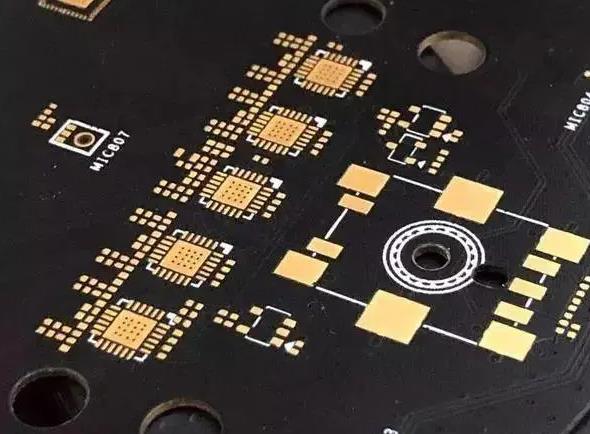The advantages of the ENIG process are that the deposition color on the surface of printed circuits is very stable, the brightness is very good, the plating layer is very smooth, and the solderability is very good. Generally, the thickness of gold is 1-3 Uinches, so the thickness of gold produced by this surface treatment method is generally thicker. Therefore, this surface treatment method is generally applied to circuit boards such as key boards and gold finger boards, because of the strong conductivity, good oxidation resistance, and long service life of gold.

Fabrication notes for PCB board gold deposition process:
1. Process Introduction
The purpose of the gold deposition process is to deposit a nickel gold coating with stable color, good brightness, flat coating, and good solderability on the surface of printed wiring. Basically, it can be divided into four stages: pretreatment (oil removal, micro etching, activation, and post leaching), nickel precipitation, gold precipitation, and post treatment (waste gold washing, DI water washing, and drying).
2. Pretreatment
The pretreatment of ENIG precipitation generally involves the following steps: degreasing (30% AD-482), micro etching (60 g/InaPS, 2% H2SO4), activation (10% Act-354-2), and post leaching (1% H2S04). To remove copper surface oxides and deposit palladium on the copper surface as an activation center for nickel deposition. If one of the links is not handled properly, it will affect subsequent nickel and gold precipitation, and lead to batch scrapping. During the production process, various potions must be regularly analyzed and supplemented to be controlled within the required range. More importantly, for example, the micro etching rate should be controlled at "25U-40U". When the copper content of the activated liquid medicine is greater than 800PPM, a new cylinder must be opened. The cleaning and maintenance of the liquid medicine cylinder also has a significant impact on the quality of the PCB. In addition to the oil cylinder, the micro etching cylinder, and the post immersion cylinder, the cylinder should be changed every week, and each water washing cylinder should also be cleaned every week.
3. Nickel precipitation
As chemical nickel has strict requirements for the composition range of the solution, it is necessary to analyze and test twice per shift during the production process, and add a Ni reducing agent based on the bare copper area of the production board or experience. When adding materials, the principle of small amounts of dispersed and multiple replenishment should be followed to prevent local plating solution from reacting violently, resulting in accelerated aging of the plating solution. The PH value and temperature of the plating solution have a significant impact on the nickel thickness, The temperature of nickel solution should be controlled at 85℃-90℃. When the PH is between 5.3-5.7 and the nickel cylinder is not in production, the temperature of the nickel cylinder should be reduced to about 70℃ to slow down the aging of the plating solution. The chemical nickel plating solution is sensitive to impurities, and many chemical components are harmful to chemical nickel, which can be divided into the following categories: inhibitors: including Pb. Sn. Hg. Ti. Bi (heavy metals with low melting points).
4. Gold sinking
The ENIG precipitation process is the enig process. The main component of the gold precipitation tank is Au (1.5-3.5g/L), and the binder is (Ec0.06-0.16mol/L). It can replace pure gold plating on the nickel phosphorus alloy layer, making the plating layer smooth and finely crystallized. The pH value of the plating solution is generally between 4-5, and the control temperature is 85-90 degrees Celsius.
5. Post processing
Post treatment is also an important step. For printed circuit boards, it generally includes steps such as washing with waste gold, DI washing, and drying. If conditions permit, a horizontal plate washer can be used to further wash and dry the gold plate. The horizontal plane plate washer can be washed with liquid medicine (sulfuric acid 10%, hydrogen peroxide 30g/L), high-pressure DI water washing (30-50PSI), DI water washing, blow drying, and drying procedures are set in order to completely remove liquid medicine and water stains from the holes and surfaces of printed circuit boards, and obtain a gold plate with uniform coating and good brightness.
iPCB is a PCB manufacturer specializing in custom pcb printing, ranging from prototype PCB to small and mass production PCB. Our manufacturing services provide a high level of customized services to meet all prices and requirements.